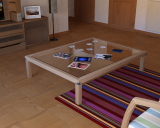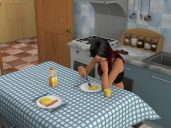Bounce, soft light
Can somebody explain to me how to create a diffuse interior light? I mean those with a light that does not flows directly through the window.
I buy ambient light, and interior light tutorial but I can not do such effect as it needs. I try to boundced light in UE 2 but after 20 minutes I got 1 percent renderer
I'd like something like that
 iray render
iray render
but it goes something like this to me



rr.png
1024 x 819 - 2M


aaav.png
800 x 600 - 881K


Comments
Ambient light is a 3Delight product, and will not work in Iray.
I made some experiemts a while ago, which might (or might not) help you: http://www.daz3d.com/forums/discussion/comment/869789/#Comment_869789
I know if I had the opportunity to take advantage of iray (i have radeon card) it would not be a problem. I just wanted to show on what effect I mean. How do something similar with 3Delight
I know that too, but rendering takes forever and sometimes end up with noise, as this first picture.
Iray also works in CPU mode, no need for an Nvidia card.
Oh sorry, then there was major misunderstanding. I had thought you were trying to achieve the iray result from the example in an iray render of your own.
About Iray, if your system can handle 3Delight well, then it can also handle Iray. It renders CPU if there's no nVidea card, or the scene is too big for your nVidea card (which is regularly the case in my system, my card has only little video ram, so I have almost all the time 100% CPU rendering of Iray). CPU is slower than GPU, but that's the only difference.
That said, I usually use AOA Advanced Ambient Light. Indoors, I add either a couple of spotlights ("ring lighting") from the direction of my light sources, or, if I have a window, I wll use AOA Advanced distrant light to pretend it's sunlight. You can play around with the shadow intensity&softness if they are too weak even if you increase the light volume. I can put something together when I'm at my PC at home, if you want.
I do not know how possible but I would be grateful :)
Okay... here are a few test render.
I start out with two distant lights - one in the room next door, shining through the ceiling light, and one coming from the right side through the windows in the room the Genesis1 sits in.
As you can see, there's plenty of shadow, and nothing bouncing off to our lovely lady. The reason for this is that 3Delight doesn't really "bounce" like Iray light does.
Even increasing Maximum Ray Trace, which is the "bouncing factor" to something higher, like 6 bounces, does not really help the problem.
Because of that, you need to improvise in 3Delight. First, you add the ambient light, as you already have done yourself. That will light up the shadows a bit.
That's looking a bit better, but still doesn't have the "bounce" effect you get in Iray. It also still looks rather flat and 2D. To achieve a bit more depth, you need spotlights. In the next picture, I have added a spotlight (turned down to 20%) coming roughly from the direction where the light comes into the room through the window.
You see that you at once get some shadows, helping to define the character's shape a bit better. Now, I do the same for the ceiling light coming from the other room.
Normally, you'd add now at least two more lights, coming from the ground to simulate the light bouncing from there. Think about the path the light would take, and aim the spotlight accordingly. A 3Delight scene requires often 8 or more lights to be properly lighted, because you have to simulate the bouncing effects to make it look "3D" rather than "2D".
Getting the lights right is one of the hardest parts to learn, and it takes the longest to learn.
In the final image, I played a bit around with the settings for the ambient light, and the position of my two spot lights.
The "Introduction to Lightening" here: http://www.daz3d.com/help/help-daz-3d-video-tutorials/ offer some very good explanation on the basics of lighting for 3Delight, which I used here to give the Genesis a bit better light.
The photo you are using for comparison uses "Environment", not just a light, to get that effect. (You can tell by the shades in the hallway, they are "ambient" and "Oclusion", handled by "atmosphere" diffusion.
In the IRay settings, you can adjust the Minimum and Intensity of the environment light. That is your ambient control. No need to add ambient shaders or lights, they are all just there.
Ambient is nothing more than telling the program to "Not draw shadows as dark", it is a Minimum "black value". Thus, having it to grey, (50% brightness, will, at minimum, draw every texture and color at 50% brightness. Setting it to 100% would draw the texture as you see it in the JPG file or PNG file, without darkening it. Leaving just "white highlights" from the lights, and "glowing burns".)
I wouldn't go higher than around 20% for ambient light, which is like a slight overcast day. (100% ambient would be like noon, without any shadows, and look fake, as noon colors would be bright, but noon shadows are damn-near solid black and sharp.)
The "effect" of "ambiance" of light, is simply a combination of atmosphere-refraction and reflections, and your eyes natural "auto-adjustment" to surrounding light, by pupil dilation. The brighter the light, like at noon, on a clear day, the more your pupils close, causing blacks to become more black, while your eye tries to combat the flood of bright sharp colors. On an overcast day, less light floods your eye, so it opens more, to see the "washed-out colors", not as sharp, and shadows kind-of disappear, but still exist. You see colors in the shadows that were normally pure black on that clear sunny day. The light is being diffused by the clouds and thick atmosphere.
Inside, the illusion is ten-fold... Home lights are real dim, so your eye opens even more, trying to "see in the dark", and shadows almost completely disappear and you are only left with light-extent darkness shadows, and deflection shadows from surfaces that do not have an ideal "reflect to your eye" angle. (The sides of an orange are darker, even if it is glossy, with light reflecting directly on it, because the angle of the side of the orange is reflecting light away from you, not towards your eye, like the front or quarter-sides.)
You relay have to play with the lights to simulate inside or outside, or select the prefab settings in the environments and other settings, for interior/exterior, etc...
Quickly, you have live-render tools on the side of your rendering screen, click the tiny square on the left... changes are immediate and it restarts the rendering for you as you change settings.
P.S. It helps a LOT to edit every objects texture/materials settings... By default, most things are un-naturally shiny and diffused, for old rendering or were never actually set by anyone. You want some gloss, like 2-15%, Most Diffuse, 2-15% reflections and some Specular... But nothing like what they have, which just makes wet-plastic models with heavy dirty varnish paint. Nature is soft and diffused. CG, for years, by default, has been cold, shiny, plastic, and overly dramatic highlights, reflections and shadows. (Poor attempts to be "universal" or "dramatic". Most programmers are not artists, and most artists are not programmers. They both have different limitations and strengths. You have to be somewhere in-between.)
P.P.S. Never use an "Advertisement" or "Staged pose" (Another person's marketing "taste", as a guide for your creations. You need your own taste. Most marketing uses unrealistic "exaggeration" that isn't captured in nature, but is artistically contrived by things like spraying models with glitter, oils, talcum-powder, using expensive stage-lights, or post-editing contrast and hilights, which is faster than trying to render tuned "ready for sale" artwork in a rendering engine.)
Thanks but I did not understand this tutorial.
I added another light which flows into the kitchen from the hallway and slid advanced spotlight that falls through the window a little more inside.
Reduced the value of the light UE2base to 20%
p.s if there is any content to buy to replace the whole mess with the light? I was thinking about Studio Light PRO .
Place a spotlight right to her, as if it was coming from the window.
Remember that you need to turn on the shadows under "Shadow" in the spotlight, or you will have no effect. Also, set the shadow to "Raytracing".
As for Studio Light Pro, I do not own it, so I can't say if it's good or not. You can always buy it, see if it's working for you, and if it doesn't you can return it within 30 days after purchase and get a refund.
I am usually using AOA ambient light, rather than UE2, but other than that, the only suggestion I can make is that you need more lights at the right places, with the right settings, and that 3Delight light does not bounce. It's something that you get the hang of pretty quickly, but in my experience, there's no "Make Art" button.
EDIT: If you haven't already, please read this thread: http://www.daz3d.com/forums/discussion/17351/some-words-of-wisdom
There is a spotlight (in the window) instead of the standard Spotlight I used advanced spotlight. Shadow value at 60 percent and shadow softness at 300%.
That shadow softness sounds much too soft to me. It may explain why all the 'connective' shadows are missing. Like between the cutlery and the table etc.
Keep the shadows strong and let the ambient light do the 'softening fill', just like real life.
This is getting weird. I swapped AoA spotlight on a normal spotlight, settings are the same but the picture looks different.
The last image looks almost right to me. The problem now, as you said earlier, is that it competes with the sunlight from a different direction.
Instead of a spotlight at the window, I would use a large area light so that the shadows are not so directional.
To get UE2 to 'bounce' you have to set it to either the 'ILT mode' or the 'Bounce GI' mode and they will slow the render significantly.